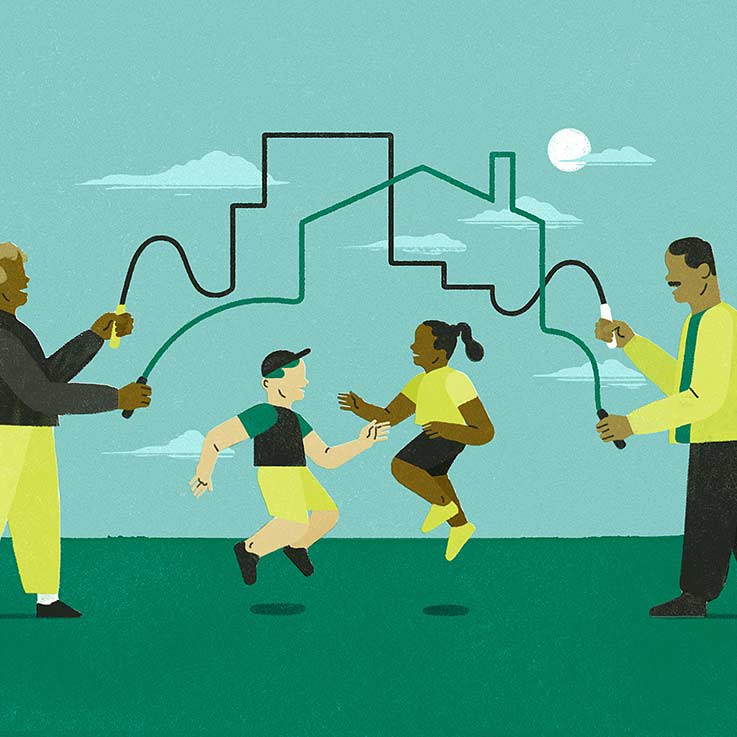
When Co-Founder Transitions Collide
When Co-Founder Transitions Collide
The work of cofounders is oftentimes so entwined that they are ready to leave the organization at the same—but who gets to go first?
By Jacob Mnookin Sep. 9, 2020
In August 2007, when I began writing the public charter school application for what would become Coney Island Prep, I’d never even heard of succession planning. I was 28, and the sum total of my professional experience included teaching high school English for three years as part of Teach for America (TFA). At the time, even if someone had explained it to me and suggested I get around to it at some point, part of me would have assumed I’d lead Coney Island Prep until I retired. It was my baby, my entire life, my passion and purpose.
A year later—with an approved application and some funding in hand—I brought on Lindsay Freeman as founding principal. Lindsay and I had met through TFA, and the two of us went about the business of opening a middle school in Brooklyn, New York. While she created a daily school schedule, ordered curriculum and books, and planned staff orientation, I put together a board of trustees, negotiated a lease for our first facility, designed uniforms, raised money, picked a payroll provider, and tried to repair a relationship with a local city councilman who told me the school would open over his dead body.
Finding the Way Forward When Founders LeaveThis essay series, produced in partnership with Generation Citizen’s Scott Warren, looks at the founder succession process through the eyes of those who have lived it, and provides lessons for social enterprises and nonprofits undertaking leadership transitions.FOLLOW THIS SERIES
Succession planning didn’t make the list until years later, when we would determine independently that it was time to hand over the reins to other people, and face the unique challenge of successfully replacing both of us while keeping the organization we built moving ahead.
Knowing When It’s Time
Five years later, we’d opened a high school and an elementary school, and were operating all three out of different locations. Each had its own principal and director of operations, and as our schools grew, our staffing model grew with it. Lindsay became our chief schools officer, coaching and managing the principals. We also hired a chief financial officer to help oversee our $21 million budget; a chief people officer to manage our human resources and recruitment functions; a chief operating officer, who managed the directors of operations; and a chief academic officer who oversaw our K-12 curriculum and assessment program. With a bigger staff, there were new challenges to figure out—and succession planning still didn’t make the list of priorities.
As the organization evolved, so did my relationship to it. In the start-up period, every day brought a brand-new challenge I was energized to solve. Seven years in, the work didn’t feel exciting anymore; the challenges were no longer new. The first time I negotiated a lease for a school building, I found the process engaging, even thrilling. I poured over the details and loved learning along the way. The second time, it felt less interesting, but the $3 million renovation we planned presented its own learning curve. The third time, I felt tired. Negotiating the lease was still challenging, but the challenge was familiar, and I felt like I wasn’t growing. Increasingly, I found myself going through the motions. I knew that Coney Island Prep deserved an executive director who was more excited about the day-to-day work than I was, and I wanted to find the passion and excitement I once had in a new endeavor.
Communicating Early and Often
For us, the startup years brought so many fires to put out that it almost felt irresponsible to dedicate time to succession planning. But in hindsight, once we’d entered a phase where systems, procedures, and best practices were codified, succession planning should have become a part of the annual planning cycle. That would have allowed for regular conversations to take place—between senior leadership team members and me, as well as me and the board—about intentions to remain. It would have forced us to create more robust professional development plans and opportunities for internal staff members to gain insight into roles outside of their usual day-to-day responsibilities. And it would have helped us to do a better job of documenting all of the things we knew about leading Coney Island Prep but kept in our heads.
Given that we didn’t have a plan in place, I knew that finding my replacement would likely be a long, multi-year process. I also knew the board would need to play a significant role, so I started by telling the chair and vice-chair I was beginning to think about moving on. I also told them I wanted two things to be true before I stepped down. I wanted Coney Island Prep on solid ground—financially, as well as in terms of academic achievement, and staff and student culture—and I wanted a strong senior leadership team in place. When we could agree we’d achieved both, we would begin the search for a successor.
Shortly after that conversation, during one of our weekly check-ins, Lindsay told me she thought it was time for her to leave the organization. Her announcement caught me off guard; somehow, just as in the early years I assumed I’d be at Coney Island Prep forever, I thought Lindsay would never leave. I suddenly realized that while I’d done a good job of communicating my own intentions early on to the board, I hadn’t communicated with Lindsay—and she was similarly surprised.
In retrospect, of course, it makes sense that the feeling struck us both at the same time. Our work was deeply entwined from the beginning; we’d weathered the same ups and downs. Growing Coney Island Prep from one school with 90 students and 12 staff to three schools with more than 1,000 students and 175 staff was exciting and fulfilling, but it was also really, really hard. Both of us were tired and ready for something new. But there was a problem: When cofounders want to leave at the same time, who gets to go first?
Doing What’s Best for the Organization
As the executive director, it seemed to me that as difficult as it was to acknowledge, we should stagger our departures, and Lindsay should go first. Leaving at the same time would strain the organization, and the risk of something going wrong was too high. If Lindsay left first, it would give me the chance to hire her replacement and ensure that that transition was going smoothly (part of having a strong leadership team in place) before stepping down myself.
We started by engaging a search firm to help us find Lindsay’s replacement in the fall of 2017, and I created an ideal succession timeline:
- January 2018: Begin search for new chief schools officer
- May 2018: New chief schools officer begins
- August 2018: Lindsay leaves
- September 2018: Deputy executive director begins, with the expectation that they will take over as executive director after one year
- April 2019: Public announcement of my intention to step down
- July 2019: New executive director takes over
- December 2019: I leave Coney Island Prep after supporting new executive director through the transition
We also decided that Lindsay would have input into the chief schools officer job description and the design of the selection process, including interview questions and practical tasks, but that she would not actively participate in the interview or the decision about who to make an offer to. She would have lunch with candidates during final interview days, mostly with the intention of giving candidates the opportunity to ask her questions. This seemed most comfortable for both Lindsay and me. While we generally agree on most things, and tend to share similar views on hiring, we wanted to avoid a situation where she loved a particular candidate and I did not, or vice versa. Having her actively participate in the interview process seemed like it could lead to disagreements that would unnecessarily stress an already challenging time.
Being Prepared for Brilliant Plans to Fall Apart
I feel extremely lucky that both of our transitions worked out along the timeline I conceived. Through the search firm, we found an incredible person to take over as chief schools officer, Eldridge (El) Gilbert. I onboarded and managed his transition, and he has performed admirably. He has helped Coney Island Prep successfully navigate the tricky waters associated with remote teaching and learning, all the while keeping issues of equity and what’s best for children at the fore.
It’s just as likely, however, that something could have gone wrong. What if Lindsay’s replacement hadn’t worked out? What if, after Lindsay left, our academic achievement on New York State standardized tests decreased? What if we experienced a wave of staff attrition? What if we had to replace a principal or director of operations at one of our three schools, and to focus our time, effort, and energy on stewarding a school through its own leadership transition? Going into the 2018-2019 school year, things had to work out perfectly for me to leave according to plan, so I mentally prepared myself to stay on longer just in case. While I was hoping to step away from the organization in December 2019, I knew that circumstances on the ground might require that I stay into 2020.
Fortunately, things did work out according to plan, and I left Coney Island Prep at the end of December 2019. The ultimate measure of a successful transition or co-transition, however, is whether the organization improves after the founder or founders leave. Time will tell whether or not that goal becomes a reality for Coney Island Prep, but prioritizing what was best for the organization throughout the process—even without a formal, longstanding plan—has helped make the organization’s future success that much more likely.










